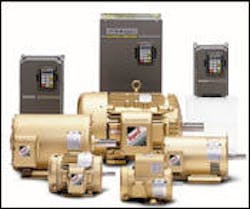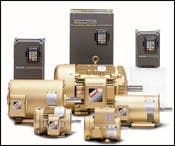Motor Decisions Matter: It's Time to get Serious About Conservation
By Edward H. Cowern
With energy prices escalating at an unprecedented rate it is time to take another look at what can be done to control and minimize power costs. Regardless of your feeling about the crisis, its source, and long term solutions, there are actions you can take now to control energy costs, even as you add new equipment to a facility.
Statistics show that 3-phase induction motors consume nearly two-thirds of the power generated in the United States. Even though all 3-phase motors are relatively efficient in converting electric power into mechanical power, there are now motors available that can do a more efficient job. The use of these motors becomes even more important as the price of electricity heads towards the stratosphere.
In order to put the importance of motors into perspective a few rules of thumb might come in handy.
At 10 cents a kilowatt hour it costs approximately $2 per horsepower per day to run a motor at full load. At first glance this might not look like a lot, but when you add up the cost for a month or year, it becomes substantial. For example, the cost of operating a 10 hp motor continuously for a year would total $7,000, while a 100 hp motor would be about $70,000. At 15 cents per kilowatt hour, which is likely in the near future, these numbers balloon to over $10,000 and to over $100,000. A small percentage improvement in the efficiency of the motors or in the method of operation can have a dramatic impact on energy costs.
On motors that run 10 to 24 hours a day, the energy cost of operating the motor is so great that the first cost of the motor is almost insignificant. A 5 hp motor that might cost $250 to purchase, could, at 10 cents a kilowatt hour, use $35,000 worth of energy over a 10 year life. This would make the initial cost less than 1 percent of the operating cost.
The federal government has recognized the need for conservation through improved efficiencies and enacted the EPACT law (Energy Policy Act) to mandate efficiency upgrades on all standard motors. The implementation of this law was spread over two years, but it is now fully implemented. Thus, buying a new motor today for a new installation or for replacement of a failed motor insures a certain minimum level of performance, but even higher performance is available.
The Consortium for Energy Efficiency (CEE) has developed a table of efficiencies that goes beyond those mandated by the government in 1997. This table has been used by many utility companies to encourage the use of premium efficiency motors by offering rebate programs. CEE motors are readily available in all normal enclosures and speeds so that they will cover a high percentage of 3-phase motor applications in the 1-200 hp range.
The efficiency difference between the now standard EPACT motors and the CEE efficiency levels is subtle. For example: 2.7 percent at 5 hp, 1.5 percent at 50 hp and 0.9 percent at 100 hp. But at 15 cents a kilowatt hour, even modest improvements pay for the incremental first cost differences quickly.
If you think your facility has motors that are too small to be important, or that the overall facility is too small to yield to these efficiency improving steps, think again! As it turns out, the biggest percentage improvement occurs on small motors. For example, the difference between standard and premium efficiency motors at 1 hp is 3 percent greater than it is at 50 or 100 hp. This means the smaller commercial and industrial operations have "percentage wise" the most to gain by selecting the CEE improved efficiency motors.
Once you have a plan in place to upgrade motor efficiencies, a second step can be considered: the use of variable frequency controls to optimize the operation of motors, especially those used on centrifugal pumps and air handling blowers within a facility.
By way of background, adjustable frequency controls can vary the speed of 3-phase induction motors very simply. Variable frequency drives (VFDs) have been used for many years on machine tools and other industrial requirements to optimize the process speed to match the material being handled, etc. This can dramatically improve the output of machinery and the efficiency of the process. But it does not have an impact on energy usage.
There are, however, other requirements in both commercial and industrial settings where the use of VFDs can make a big difference in energy costs and improve operations as well. The concept is much different.
First, when you look at things like centrifugal pumps and blowers used in heating, ventilating, and air conditioning (HVAC) systems, the horsepower and energy requirements of the systems vary dramatically with the speed. For example, slowing a centrifugal pump by 10 percent will reduce the energy required by nearly 30 percent.
In municipal water systems, quite often operators are really trying to control pressure from a pump. One of the traditional methods is a valve that restricts the pipe opening. While decreasing the pressure and flow on the outboard side of the valve, it greatly increases the pressure on the pump side of the valve. This is like pushing your foot down on the gas pedal for power and using your brake for speed control.
It can be much more efficient placing a pressure transducer (if controlling pressure) or a flow transducer (if controlling flow) in the system and feeding that back into the inverter (if it has process control on board). The inverter will regulate the pump speed to maintain the desired pressure or flow you set. If the inverter does not have set point or process control, you may use a separate process controller or system management package to compare the set point to the feedback, filter the change through a mathematical equation typically called PID (proportional, integral, differential) and feed the resulting speed signal to the inverter typically a 4-20mA command.
Please be cautioned to look at the system curve before investing in an inverter. Pure lift systems require a lot of static head before flow commences. The pressure (especially on centrifugal pumps) varies with approximately the square of the speed change. This means that as the speed decreases, so does the pressure. If the pressure dips below the static head, you are no longer a pump but have turned into a water heater. This is a common misapplication of inverters. However, for systems with a lot of piping losses, a tremendous amount of energy can be saved from the use of inverters. A look at the system curve, pump efficiency and flow requirements should be reviewed to savings calculations. A number of software programs are available for free from both pump and inverter manufacturers to help calculate the savings.
Conclusion
Will implementing aggressive conservation and efficiency programs help avert a "Rolling Blackout"? No and Yes. If it is done in your facility it can help minimize your electric bills but it won't do much to reduce the likelihood of your participation in a blackout. But if every facility were to do its best to upgrade efficiencies with improved motors and controls, enough energy could be saved to "shave the peaks" and reduce the likelihood of blackouts for everyone. The threshold for utility capacity trouble is relatively narrow and conservation can help buy time for everyone until new power sources become available.
About the Author: Ed Cowern is a retired Baldor District Manager (New England Territory) who has extensive utility and motor experience. Ed is a registered Professional Engineer in Connecticut. He can be reached at 203-239-3163 or fax at 203-239-2833 or e-mail at [email protected].

